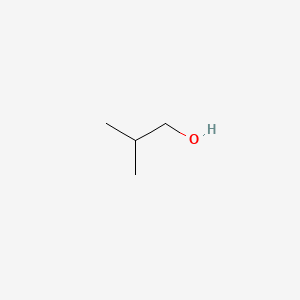| MeSH term | MeSH ID | Detail |
|---|---|---|
| Diabetes Mellitus | D003920 | 90 associated lipids |
| Diabetes Mellitus, Type 1 | D003922 | 56 associated lipids |
| Body Weight | D001835 | 333 associated lipids |
| Angina Pectoris | D000787 | 27 associated lipids |
2-methyl-1-propanol
2-methyl-1-propanol is a lipid of Fatty Acyls (FA) class. 2-methyl-1-propanol is associated with abnormalities such as FRIEDREICH ATAXIA 1, Amelia, Tuberculosis, purging and Tuberculosis, Pulmonary. The involved functions are known as Regulation, Oxidation-Reduction, Fermentation, Biochemical Pathway and Glycolysis. 2-methyl-1-propanol often locates in Protoplasm, Chromosomes, Human, Pair 7, BL21, Chromosomes and Cell metabolite. The associated genes with 2-methyl-1-propanol are ADH1B gene, LDHA gene, Operon, AAAS gene and SLC7A3 gene. The related lipids are Butanols, Fatty Alcohols, 1-Butanol, Fatty Acids and cyclopropane fatty acids. The related experimental models are Knock-out.
Cross Reference
Introduction
To understand associated biological information of 2-methyl-1-propanol, we collected biological information of abnormalities, associated pathways, cellular/molecular locations, biological functions, related genes/proteins, lipids and common seen animal/experimental models with organized paragraphs from literatures.
What diseases are associated with 2-methyl-1-propanol?
2-methyl-1-propanol is suspected in Tuberculosis, PARKINSON DISEASE, LATE-ONSET, Dehydration, Erythromelalgia, FRIEDREICH ATAXIA 1, Amelia and other diseases in descending order of the highest number of associated sentences.
Related references are mostly published in these journals:
| Disease | Cross reference | Weighted score | Related literature |
|---|
Possible diseases from mapped MeSH terms on references
We collected disease MeSH terms mapped to the references associated with 2-methyl-1-propanol
PubChem Associated disorders and diseases
What pathways are associated with 2-methyl-1-propanol
There are no associated biomedical information in the current reference collection.
PubChem Biomolecular Interactions and Pathways
Link to PubChem Biomolecular Interactions and PathwaysWhat cellular locations are associated with 2-methyl-1-propanol?
Visualization in cellular structure
Associated locations are in red color. Not associated locations are in black.
Related references are published most in these journals:
| Location | Cross reference | Weighted score | Related literatures |
|---|
What functions are associated with 2-methyl-1-propanol?
Related references are published most in these journals:
| Function | Cross reference | Weighted score | Related literatures |
|---|
What lipids are associated with 2-methyl-1-propanol?
Related references are published most in these journals:
| Lipid concept | Cross reference | Weighted score | Related literatures |
|---|
What genes are associated with 2-methyl-1-propanol?
Related references are published most in these journals:
| Gene | Cross reference | Weighted score | Related literatures |
|---|
What common seen animal models are associated with 2-methyl-1-propanol?
Knock-out
Knock-out are used in the study 'Redesigning Escherichia coli metabolism for anaerobic production of isobutanol.' (Trinh CT et al., 2011) and Knock-out are used in the study 'Metabolic engineering of microorganisms for the production of higher alcohols.' (Choi YJ et al., 2014).
Related references are published most in these journals:
| Model | Cross reference | Weighted score | Related literatures |
|---|
NCBI Entrez Crosslinks
All references with 2-methyl-1-propanol
Download all related citations| Authors | Title | Published | Journal | PubMed Link |
|---|---|---|---|---|
| Minty JJ et al. | Design and characterization of synthetic fungal-bacterial consortia for direct production of isobutanol from cellulosic biomass. | 2013 | Proc. Natl. Acad. Sci. U.S.A. | pmid:23959872 |
| Egorov IA et al. | [Formation of alcohols during sucrose heating with amino acids]. | 1975 Mar-Apr | Prikl. Biokhim. Mikrobiol. | pmid:1208379 |
| Fausther-Bovendo H et al. | HIV gp41 engages gC1qR on CD4+ T cells to induce the expression of an NK ligand through the PIP3/H2O2 pathway. | 2010 | PLoS Pathog. | pmid:20617170 |
| Colón M et al. | Saccharomyces cerevisiae Bat1 and Bat2 aminotransferases have functionally diverged from the ancestral-like Kluyveromyces lactis orthologous enzyme. | 2011 | PLoS ONE | pmid:21267457 |
| Lee DH et al. | Cumulative number of cell divisions as a meaningful timescale for adaptive laboratory evolution of Escherichia coli. | 2011 | PLoS ONE | pmid:22028828 |
| Chen T et al. | Laboratory-evolved mutants of an exogenous global regulator, IrrE from Deinococcus radiodurans, enhance stress tolerances of Escherichia coli. | 2011 | PLoS ONE | pmid:21267412 |
| Van Dyck S et al. | Localization of secondary metabolites in marine invertebrates: contribution of MALDI MSI for the study of saponins in Cuvierian tubules of H. forskali. | 2010 | PLoS ONE | pmid:21085713 |
| Choi H et al. | Common household chemicals and the allergy risks in pre-school age children. | 2010 | PLoS ONE | pmid:20976153 |
| Dodatko T et al. | Bacillus cereus spores release alanine that synergizes with inosine to promote germination. | 2009 | PLoS ONE | pmid:19636427 |
| Qi H et al. | Model-driven redox pathway manipulation for improved isobutanol production in Bacillus subtilis complemented with experimental validation and metabolic profiling analysis. | 2014 | PLoS ONE | pmid:24705866 |
